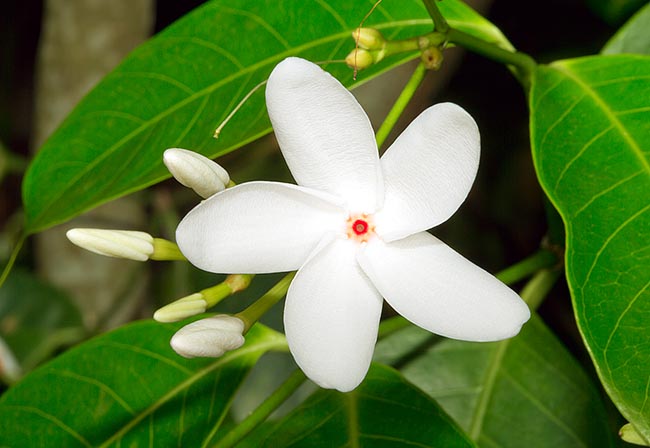Family : Apocynaceae

Text © Pietro Puccio

English translation by Mario Beltramini

At home in Malaysia and Singapore, the stylish inflorescences of Kopsia singapurensis bear several white flowers with red centre and 5 elliptic lobes of 1,5-2 cm. The 5 stamina are inside the 2,5-3,5 cm coralline tube © G. Mazza
The species is native to Peninsular Malaysia and Singapore where it lives in the pluvial and swampy forests and along the water streams at low altitudes.
The genus is honoured to the Dutch politician and botanist Jan Kops (1765-1849); the Latin specific name “singapurensis” = of Singapore, refers to one of its origin sites.
Common names: Singapore kopsia, white kopsia (English); selada (Malaysia).
The Kopsia singapurensis Ridl. (1923) is a shrub or a small evergreen tree 5-6 m tall, rarely more, with trunk of 20-24 cm of diameter with greyish bark from whose wounds exudes an irritating milky sap.
The leaves, on a 0,5-1 cm long petiole, are opposite, simple, elliptic with entire margin and cuspidate apex, about 1,2 cm long, and prominent nervations below, coriaceous, of glossy intense green colour, 8-20 cm long and 3-10 cm broad.
The inflorescences, on a 1-7 cm long peduncle, are terminal biparous cymes, 3-12 cm long, carrying numerous hermaphroditic flowers of white colour with red centre. Funnel shaped corolla with 2,5-3,5 cm long tube, 5 oblong or elliptic lobes, 1,5-2,2 cm long and 0,6-1 cm broad, and 5 stamina inside the corolline tube.
The fruits are oblong, slightly flattened, drupes, usually in pairs, 2,5-3 cm long, 1-1,4 cm broad and 0,6 cm thick, of red colour, containing one seed only.
It reproduces by seed, in organic loam maintained humid at the temperature of 24-26 °C, by air layering and cutting.

Shrub or small evergreen 5-6 m tree, it suits easily to hedges in tropical gardens but is little known out of the origin zones. Is locally used in the traditional medicine for various pathologies. Presence in bark and leaves of various indole alkaloids with antioxidant and antitumoral properties © Giuseppe Mazza
Vigorous species of easy cultivation with ornamental foliage and flowers, little known out of its origin zones, where at times is utilized in parks and gardens as isolated specimen or to form barriers, exclusively suitable to tropical and humid subtropical zones, as it does not stand temperatures lower than 7 °C if not exceptional and for very short period. It requires a position in full sun, even if bearing partial shade, and is not particular concerning the soil, even if poor, heavy and with water stagnations.
Parts of the plant are used in the traditional medicine for various pathologies; laboratory studies have evidenced the presence in the bark and in the leaves of various indole alkaloids with antioxidant and antitumoral properties.
Because of the reduction of its habitat due to the anthropic expansion, its has been inserted in the red list of the International Union for Conservation of Nature (IUCN) among the threatened species (vulnerable).
→ To appreciate the biodiversity within the APOCYNACEAE family please click here.
